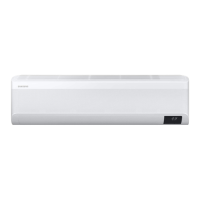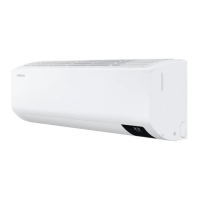In using R-32
General information
Installation of the product
• Do not use means to accelerate the defrost
operation or to clean, other than those
recommended by Samsung.
• Do not pierce or burn.
• Be aware that refrigerants may not contain an
odour.
• For the product that uses the R-32 refrigerant, be
cautious not to generate a spark by keeping the
following requirements:
– Do not remove the fuses with power on.
– Do not disconnect the power plug from the
wall outlet with power on.
– It is recommended to locate the outlet in a
high position. Place the cords so that they are
not tangled.
CAUTION
• Keep the piping length at a minimum to minimize
the additional refrigerant charge due to piping
• When connecting the pipes, make sure that
surrounding objects do not interfere with or
contact them to prevent refrigerant leakage due
to physical damage.
• Make sure that the spaces where the refrigerant
pipes are installed comply with national gas
regulations.
• Be sure to perform works such as additional
refrigerant charging and pipe welding under the
conditions of good ventilation.
• Be sure to perform welding and piping works for
mechanical connections under the conditions that
the refrigerant does not circulate.
• When reconnecting the pipes, make sure
to perform flared-jointing newly to prevent
refrigerant leakage.
• When working on the refrigerant pipes and the
flexible refrigerant connectors, be careful that
they are not damaged physically by surrounding
objects.
extension.
• The outdoor unit shall be installed in an open space
that is always ventilated.
• The local gas regulations shall be observed.
• To handle, purge, and dispose the refrigerant, or
break into the refrigerant circuit, the worker should
have a certificate from an industry-accredited
authority.
• Do not install the indoor unit in the following areas:
– Area filled with minerals, splashed oil, or
steam. It will deteriorate plastic parts, causing
failure or leakage.
– Area that is close to heat sources.
– Area that produces substances such as sulfuric
gas, chlorine gas, acid, and alkali. It may cause
corrosion of the pipings and brazed joints.
– Area that can cause leakage of combustible
gas and suspension of carbon fibers,
flammable dust, or volatile flammables.
– Area where refrigerant leaks and settles.
– Area where animals may urinate on the
product. Ammonia may be generated.
• Do not use the indoor unit for preservation of food
items, plants, equipment, and art works. This may
cause deterioration of their quality.
• Do not install the indoor unit if it has any drainage
problem.
• For the multi system, this indoor unit can be
conncected to an R-32 or R-410A outdoor unit. Check
the type of refrigerant in the outdoor unit.
• In addition to table 1, make sure that the indoor and
outdoor unit are installed in a space at least of 4m²
to guarantee the regular maintenance or service
repair.
• Table 1 (defined according to EN378-1:2008)
[Unit : m
2
]
Installation
height (m)
1.224
1.225
1.250
1.500
1.750
2.000
2.250
2.500
0.6
No limitations
12.77 13.30 19.15 26.06 34.04 43.09 53.19
1 4.60 4.79 6.89 9.38 12.26 15.51 19.15
1.8 1.42 1.48 2.13 2.90 3.78 4.79 5.91
2 1.15 1.20 1.72 2.35 3.06 3.88 4.79
2.2 0.95 0.99 1.42 1.94 2.53 3.20 3.96
•IMPORTANT: it’s mandatory to consider either
the table 1 or taking into consideration the local
law regarding the minimum living space of the
premises.
•Minimum installation height of indoor unit is 0.6 m
for floor mounted, 1.8 m for wall, 2.2 m for ceiling.
Charge
amount (kg)

